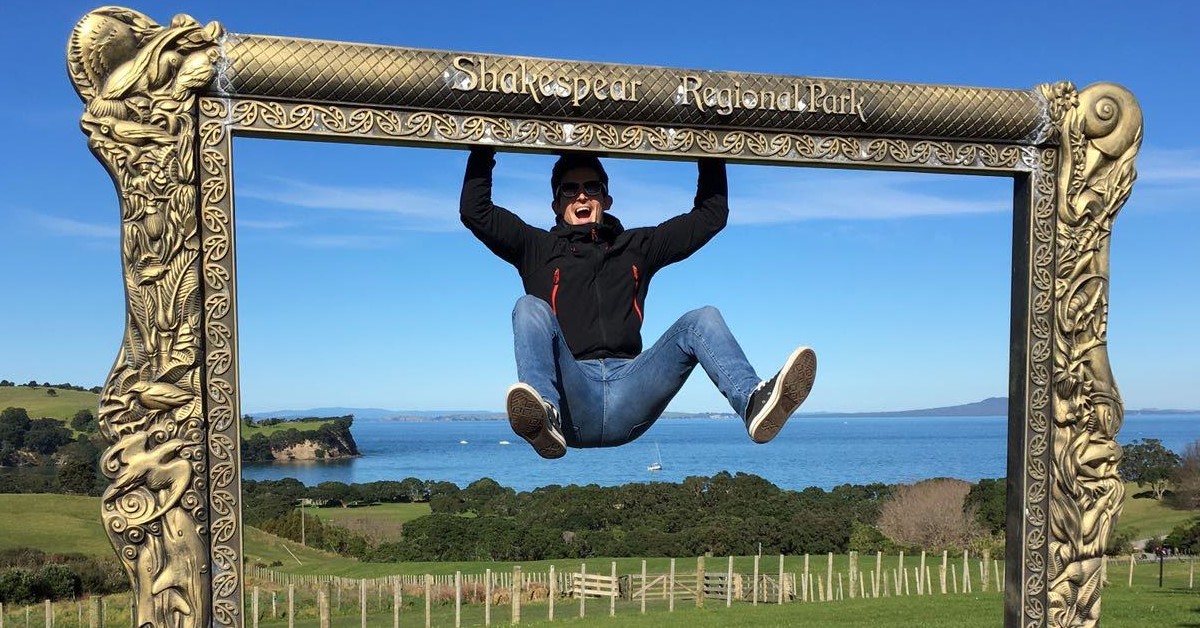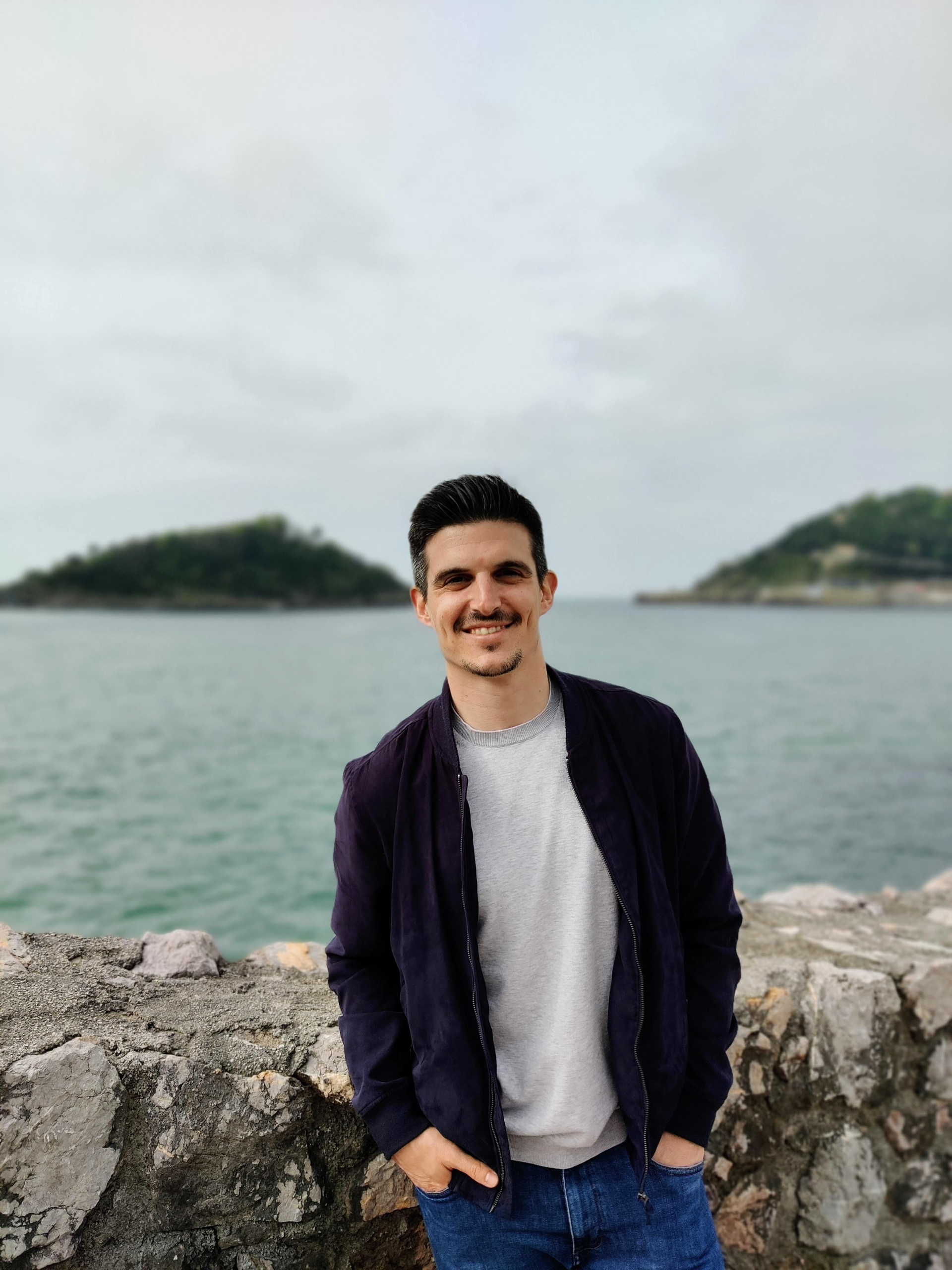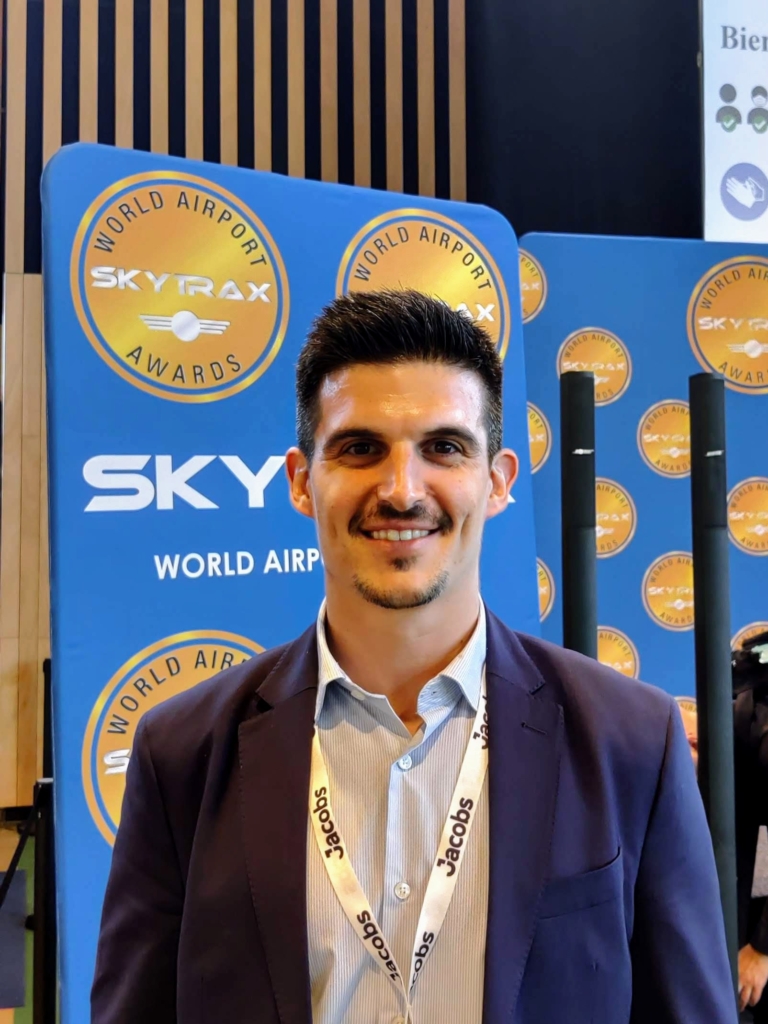Airport Planning and Management alumni stories: Principal Airport Planner Eduard Clerch in Madrid
21/06/2022

Eduard Clerch is a Team Leader and Principal Airport Planner at Mott MacDonald in Madrid, Spain. He graduated from Cranfield University with an MSc in Airport Planning and Management in 2012. Here, Eduard talks about his life-long love of aviation, how studying at Cranfield kickstarted his career, and his varied and exciting role within the airport industry.
What sparked your interest in the air transport industry?
Having been exposed to architecture through my dad’s job and thanks to endless hours of playing with LEGO, I have always had a fascination with building stuff. Much to my parents’ frustration, I only wanted to build sandcastles on the beach using my construction scale models instead of playing in the water until wrinkly!
It was always a thrill to fly on airplanes as a kid and it also happens that my family has a tradition of “breeding” aeronautical engineers, plus some other relatives are linked to the aviation industry one way or another. But what really got me into airports, apart from their addictive complexities, was watching for the first time the opening scene from the movie “Love Actually”, when Hugh Grant describes airport terminals as fascinating places where people reunite with their loved ones while everything flows in motion. For some reason, that stuck with me and I realised that, even though airports run on a schedule, not a single day is the same.
In an expected move, after completing secondary school I enrolled at Universidad Politécnica de Madrid to study aeronautical engineering. However, instead of dealing with aerodynamics, aircraft frames and engines, I specialised in air transport, navigation systems and, eventually, in airports.
Why did you choose Cranfield?
After completing my undergraduate degree and deciding I wanted to pursue further studies, Cranfield quickly became my first choice after searching for options both at national and international levels. I was determined to specialise in airport planning and Cranfield’s MSc in Airport Planning and Management was without a doubt the best option out there, as it remains to date.
After becoming a student you realise how well-connected Cranfield University is with the industry, both through the alumni network as well as through professional relationships. The calibre of the teaching staff and guest lecturers speaks for itself. You get the opportunity to meet and listen to some of the most recognised professionals in the air transport industry with lots of experience, who are driving the innovation process.
Those links with industry are what make Cranfield an excellent choice to pursue postgraduate studies as it positions students for entry-level and mid-level roles within the top airlines, airport operators, consultancies, and key organisations within the aviation industry.
How did you find the course? What were the highlights?
Even after a decade, I cherish my time at Cranfield very much. Even though the overall year is quite intense and demanding, the benefits you reap in the end make it completely worthwhile. One also gets to enjoy the full experience of living in the English countryside surrounded by like-minded people from all over the globe and attending lectures from top professionals in the industry.
I went to Cranfield with a solid technical background from my undergraduate degree, but the MSc in Airport Planning and Management equipped me with the more transversal skills and knowledge that have made me a better professional over time. The course offered me an understanding of finance and business subjects, sustainability aspects and brought in the most innovative thinking in the industry. I also had the opportunity to improve my communication skills by presenting in front of peers, lecturers and industry delegates while starting to develop my own professional network.
The close relationship that students can have with both resident and guest lecturers makes you feel part of the aviation industry upon setting foot at Cranfield. This empowered me at the time to make the most out of the course knowing that, even as a student, you can have a positive impact in the industry right away.
At a personal level, I grew a lot as an individual during my time at Cranfield. Some of the friendships and relationships I built during my time there are still strong to date. And I couldn’t forget to mention the nights spent at the CSA, which made the experience undoubtedly more pleasant. The fact that the air transport department’s old building was at the time next to the CSA made it almost… inevitable.
What has your career path been since graduating?
Upon completing the group project at Cranfield I was invited to attend an interview with Mott MacDonald for a graduate airport planner role based in London. After a series of interviews and workshops, I was offered a position and joined the team right after the summer. Moving forward 10 years, I’m still with the same company, being fortunate enough to have lived in three different countries and travelled to many more off the back of projects.
I initially spent three years based in the UK before moving to Australia. During my time in Melbourne, I helped set up our aviation team in the region and took on additional responsibilities by managing multidisciplinary teams, delivering projects across Australia, New Zealand, and South-East Asia.
In late 2018 I relocated to Madrid to lead the aviation business in Spain for Mott MacDonald. My reach continues to be global but now focusing more on Europe and the Americas. In my role, I manage and coordinate a team of 20+ individuals providing airport strategic planning, capacity optimisation studies and technical advisory services to a wide range of public and private clients.
During my career, I have had a well-rounded exposure to many aspects involving the strategic planning, development and operation of airports covering all sorts of technical, traffic, business, and financial aspects. To date, I have worked on a wide range of projects including some of the world’s top airports (London Heathrow, Singapore Changi, Hong Kong, Melbourne, Auckland, New York JFK, Barcelona), as well as for many medium-sized and regional airports all over the globe. But more importantly, I have met and worked with great people along the journey, including several Cranfield alumni that are part of the aviation team at Mott MacDonald.
What does a typical week look like for you?
I’m involved in delivering airport master plans, feasibility studies, development plans and design projects. I also participate in and lead the provision of due diligence and technical advisory services as part of airport concessions and privatisation deals around the world. This broad remit means no project is the same as I get to work for public agencies, operators, contractors, investors and lenders.
In my current role at Mott MacDonald, I coordinate and manage the technical delivery of projects or specific workstreams. Depending on the nature of the project, the teams range from 3-4 people all the way up to 50+. Over time I have also picked up responsibilities in business development and account support, including that of clients and strategic partners. In my team management duties I also look after the utilisation of the individuals within my resource group across the various projects we have running in parallel, acting also as line manager and mentor to more junior colleagues in the team.
Lately, I have picked up responsibilities in driving forward the digitalisation of our delivery, including items such as data management and analytics, 3D visualisation, common data environments, etc.
It has been a difficult time for the aviation industry. How have you been impacted professionally?
The recent global pandemic has caused unprecedented consequences and has tested at many levels our resilience as professionals in the air transport industry and as members of society. I was lucky enough to keep my job during the worst times of the pandemic and I was able to continue working on projects, but other colleagues, unfortunately, experienced the worst side of it; they were either made redundant or even forced out of the industry altogether. There were times when “utter uncertainty” was the only certainty and long-term planning just meant two weeks ahead.
With a few exceptions, our industry is still suffering the consequences and, while we seem to have gone past the worst of it, it will still require two or three more years before traffic recovers its pre-pandemic levels at a global scale and confidence to travel is restored in full. But of course that presents itself with some interesting opportunities for the aviation industry to explore as well…
What would you say to someone who wants to work in the air transport industry?
I think the air transport industry thrives because passionate people are part of it, and you don’t really need to convince anyone who is passionate about something already. It is important to realise though that our industry, like many others, is driven by peaks and troughs, and we are now just recovering from rock bottom.
I would say that now is a perfect moment to get into the air transport industry. There are challenges ahead and everyone has a part to play, including airlines, airports, regulators, governments, and stakeholders. The industry has the opportunity to bounce back but in a more sustainable, responsible, and resilient manner, ready to learn from its past mistakes. Anyone who wants to join the air transport industry today needs to muster all enthusiasm and drive they can in order to have a meaningful contribution by challenging the old norm and redefining the rules. As a colleague of mine says: “Change in the aviation industry can only happen from those within it.”
What do you think the future holds for the aviation industry? 
The most imminent challenge is the recovery of air traffic to pre-pandemic levels as international borders start to reopen, vaccination is made available globally and confidence to travel is restored.
However, having experienced unprecedented and sustained growth over the past decades, I think it is inevitable for the future to be all about managing growth in a responsible manner. Being responsible today means doing things sustainably and considering the environmental and social impacts of air transport. Some call this the “social license to operate”, where airports, airlines and key players in the air transport industry need to continue delivering the benefits to society but actively mitigating and compensating for their downsides. From a sustainability perspective, future trends for aviation include energy transition (consumption efficiency, renewable sources, new fuel types, etc.); infrastructure decarbonisation; environmentally managed growth; climate change and resilience.
On the other hand, there are a few things where the aviation industry is just latching on. For example, the next wave of technological disruption in the form of increased automation and AI; adoption of biometrics and blockchain; data privacy and storage; further customisation of services/products, to name a few. There is also the advent of new transport forms such as urban air mobility concepts (eVTOL) and their integration with airports and urban areas; the implementation of competing yet complementary transport modes (e.g. high-speed train); the slow demise of the private car, etc.
Is there anything else we should know about you?
A bit about myself… I’m an avid traveller that enjoys discovering the world through gastronomy – and I travel to keep my Avios account in a healthy state, of course! I’m also a keen sports fan who likes to exercise for self-care and to keep my mind clear. I prefer the beach (though I don’t build sandcastles anymore), but I do love the peace and quiet of hiking up a mountain. I like talking about sensible politics (scarce these days) while appreciating a good cup of coffee, a nice bottle of wine if it comes with a cork, or a gin and tonic if it’s five o’clock somewhere in the world. I do miss Nando’s from the UK.
If you’re interested in studying Airport Planning and Management MSc at Cranfield, you can find out more about the course and how to apply here.
Categories & Tags:
Leave a comment on this post:
You might also like…
Preparing your work for Turnitin submission
Before submitting your work into Turnitin for similarity checking, if you have used referencing software then you may need to take some important steps first. Mendeley and Zotero integrate with MS Word by embedding field ...
The fast track to supercar engineering: My Cranfield journey
It’s been a dream come true to work on some of the world’s most prestigious supercars – the Aston Martin Valhalla, McLaren 750 & Artura, the GMA T.33. But every successful ...
Automotive Engineering: From student to hypercar innovation at Rimac
We sat down with recent graduate Thomas Perrin, to discuss how his year on the MSc in Automotive Engineering at Cranfield University propelled him from the lecture hall directly into the ...
What this year at Cranfield really meant to me
Every Cranfield journey is unique. In this alumni reflection, Zachea Scicluna shares what her year at Cranfield truly meant, from facing uncertainty to gaining hands-on experience in industry-backed projects. I’ve been reflecting (and delaying) ...
Preparing for assignments and exams?
Sorry! We know it seems a bit mean to mention the exams in January rather than looking forward to the break before it! However, we know many of you will be thinking about your forthcoming ...
Screening for FTSE 100 companies on Bloomberg
So you’re researching an index and need some data on its constituent companies? Bloomberg’s Equity Screening tool makes light work of this, not just for the FTSE, but for indices, exchanges and sectors worldwide. Type EQS ...






